Why? Well, there have always been rumours about the precarious fate of haute couture. Its future has been debated and doubted time and time again ever since Cristóbal Balenciaga wilfully shuttered his couture house in 1968 because he felt there was “no one left to dress”. To be clear, we’re talking about the very specific term ‘Haute Couture’, which, though often tossed around in fashion parlance, is in fact strictly defined by law in France. Referring to the one-of-a-kind ‘high dressmaking’ (a direct translation) that only a handful of fashion houses are permitted to call ‘haute couture’, the sacrosanct rules, which the French are sticklers for, are what makes haute couture so sky-high. The Chambre Syndicale de la Haute Couture decrees that a garment must be made to order by hand — in Paris, of course — and it must be fitted on a client in person at least once so that there will never be two couture clients who own the same style. Anything that falls short of such regimental rigour while using the hallowed term ‘haute couture’ is practically punishable by the guillotine.
In many ways, haute couture has always been in crisis; it has survived world wars, economic disasters, and generally, the current cultural appetite for ‘eating the rich’. Questions are always asked: is it just an indulgence of the 0.0001 per cent? A marketing vehicle at the zenith of fashion’s pyramid to boost perfume sales? Or is it a laboratory of pure creativity, un-compromised by commercial concern – the closest fashion can get to fine art? The answer always comes down to the human aspect; after all, couture is ultimately about the craft. Thousands of hours, countless hands (or petite mains as they’re known in the ateliers) and the world’s most precious materials are transformed by highly skilled dressmakers into clothes to last a lifetime. Sure, only a few can afford them, but haute couture encapsulates the existential argument of fashion itself — it is an opportunity to ask the big questions about fashion in relation to the wider world. That said, here’s everything you need to know about this season’s couture shows.
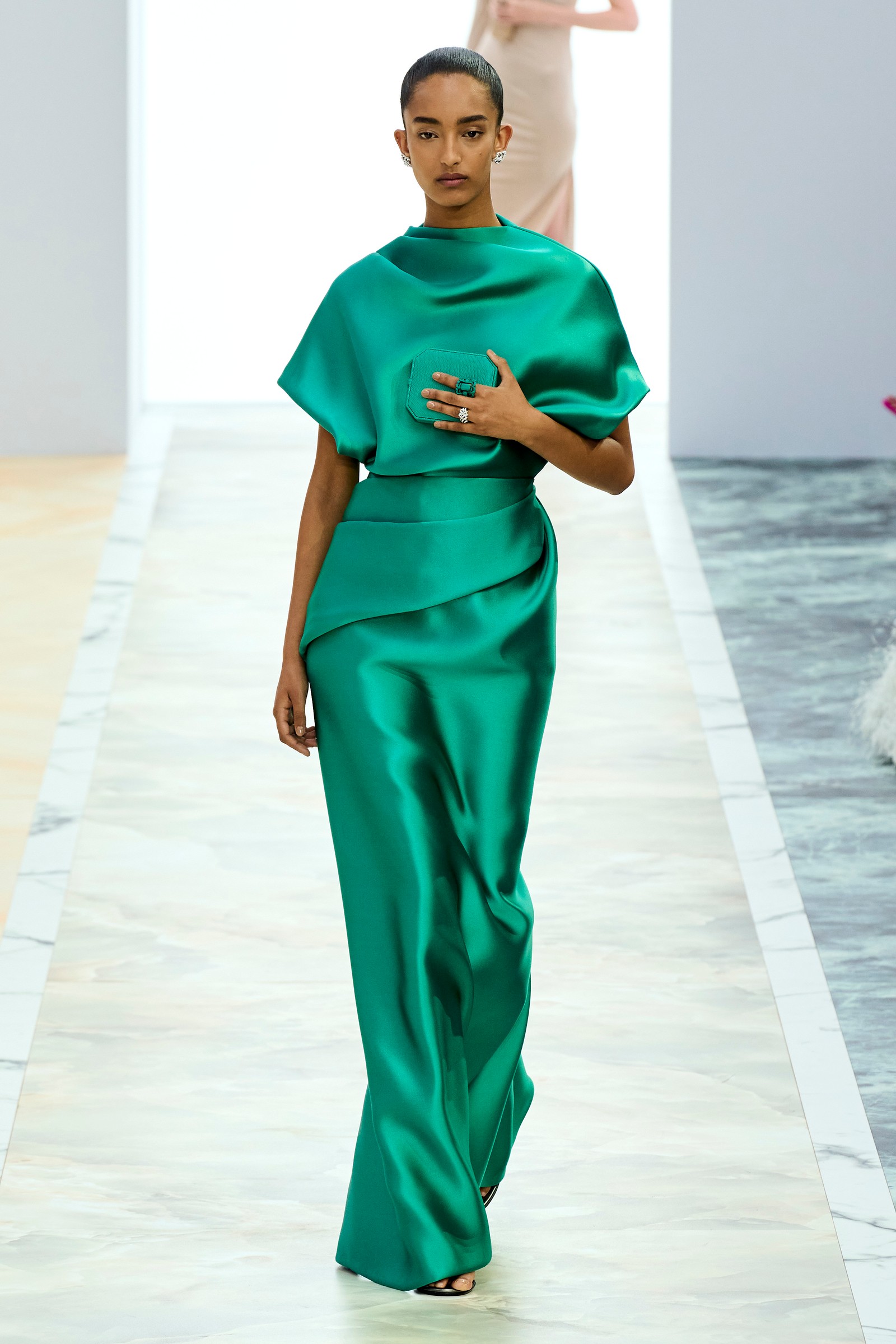
Fendi Couture A/W´23
When Kim Jones took the reins of Fendi, one of his first appointments was Delfina Delettrez as the artistic director of jewellery: a woman whose effortless elegance has offered him endless inspiration since, and a masterclass in speaking the family’s language. His latest couture collection offered her the opportunity to expand her own by launching Fendi’s first full foray into high jewellery, with the clothing created to amplify its staggering sparkle.
Second-skin drapery and fluid, mobile forms balanced the drama of their presence in a masterclass of making diamonds appear (almost) like quiet luxury. Kim is obsessed with the women who buy and wear his couture, and this spoke to their quest for the ultimate elegance, expertly crafted and without gimmicks. Even as gems descended from necklaces and earrings to find their place nestled within Persian lamb, or forming fantastic mosaics of jewels, they maintained a sense of ease; a shrugging nonchalance. What could possibly be more elegant than that?
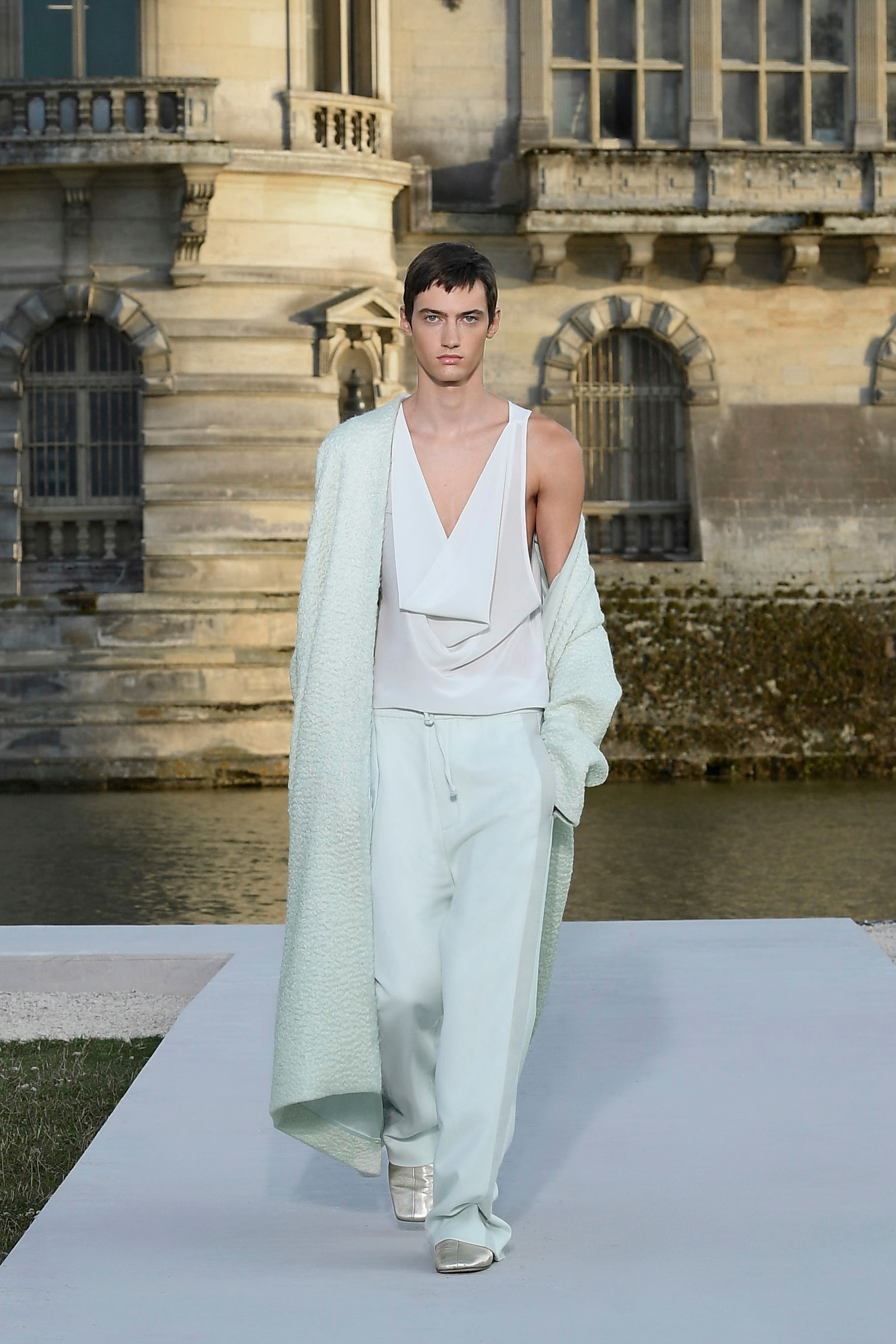
Valentino Couture A/W´23
On the penultimate evening of couture week, the fashion pack settled in for a long journey to the Valentino show, heled 30 miles north of Paris in the idyllic surroundings of the sixteenth-century Château de Chantilly, a fairy-tale castle that you’ll probably recognise from the many films that have been shot there. This was a setting of the grandest proportions, apt for the real-life princesses sitting in en plein air in the gardens of the castle, surrounded by fountains and lush gardens while the sunset turned the sky a peachy apricot as the show commenced. But the first look, worn by Kaia Gerber, was a bit more modern-day Cinderella, pre-makeover montage, in a pair of slouchy jeans, an oversized white shirt, and flat shoes emblazoned with bows and crystal earrings that could have been haphazardly snatched from the ceilings of the chateau. Jeans, you ask? Yes, jeans. Except these were reprised from classic vintage Levi’s and actually made of silk gazar, entirely embroidered in micro beads dyed 80 different shades of indigo to resemble denim, but still. They were jeans.
Welcome to the new world order of luxury in 2023, as surreal and discombobulating as a Dalí painting. Not since the days of Marie Antoinette playing dress up (or down, rather) as a simple shepherdess has this chateau seen such an opulent display of ordinary clothes. Valentino’s Pierpaolo Piccioli described the look as “a simply paradoxical trompe-l’oeil”. He’s not alone in his examination of everyday basics — Bottega Veneta’s leather jeans cost more than a second-hand Volvo, and there have been one-of-a-kind distressed jeans at Balenciaga since the house arrived on the haute couture schedule. “It’s somehow paradoxical to show in a historical site that I believe is a metaphor for status and power, a symbolism that has to be questioned and re-contextualized,” Pierpaolo told journalists. He borrowed from the artist Constantin Brancusi’s maxim that “simplicity is complexity resolved”.
Suffice to say, there were more jeans — some with outrageously ornate gold embroidery — as well as dramatic robes (some were even ermine), double-faced cashmere capes, towering feathered headdresses, billowing silk gowns and a handful of disco-goddess gowns with plunging necklines and big Donna Summer hair. All of it came in Pierpaolo’s masterful colour palette, zingy and saturated in every shade of the rainbow, but most especially fabulous, when it came in that signature deep Valentino scarlet. The simplicity could be found in the clean lines of column dresses and tunics that were softly draped and cut on the bias, even if many of them came with labour-intense embroideries and in vibrant colours that gave maximum impact to even the most minimalist of shapes. It was a tale of two moods, which feels apt for right now. We’re living in strange times after all in which everything is everywhere, all at once – chateaus and protests; quiet luxury and blingy logomania; jeans and haute couture.
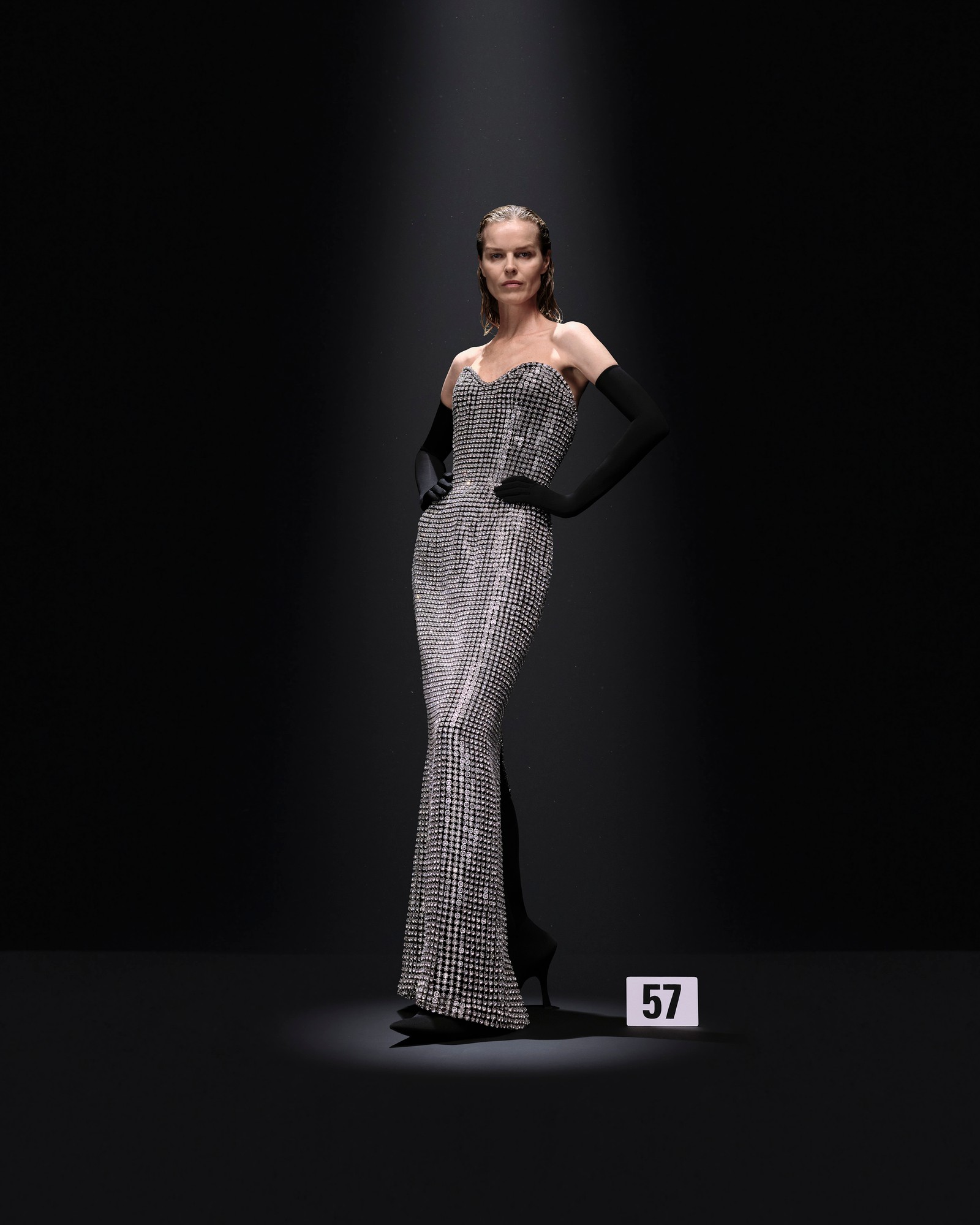
Balenciaga Couture A/W´23
But the intention of Demna’s couture, he explained, is now about precisely the opposite. “We live in an industry which is in a very critical state, full of fake creativity and imposterism in fashion,” he continued. “Couture to me is the only tool, the only way, to shed light on what’s really the essence of this job: making real clothes, the essence of creativity, and not the endless marketing and selling that has cannibalised the whole industry.” Hence, the painstakingly precise evolutions of his craft showcased through razor-sharp silhouettes; wind-swept clothing which, moulded in the making, defied gravity; astonishingly hand-painted trompe l’oeil canvases. His new takes on normcore were rigorously exacting: the result of endless streams of fittings, elevating the banal into the exceptional. “I like the couture that you see but I also like the couture that you don’t see,” he said. But look, Demna is the designer of a generation: he knows how to meticulously evolve the métiers he reveres while upending the algorithm. What he’s working out in the storied 10 Avenue George V salon is how to adapt the language of his forefather for the modern day.
The first look - a reimagination of house model Danielle Slavik’s favourite Balenciaga dress, originally made for her in 1966 by Cristobal himself - firmly established the bridge between then and now; the last - a CAD-designed, 3D-printed gown of armour, worn by Demna’s own version of a house model, Eliza Douglas - translated Cristobal’s sculptural forms which stood away from the body into video game territory, a space familiar to the house which has already played in that realm. “Cristobal used to say the metiers were his armour - and they are the place where I reconnect with myself,” explained Demna. “A protection; a safe place.” Fashion has all too few of those currently – and he knows that better than most, but he’s certainly expanding the boundaries of his own.
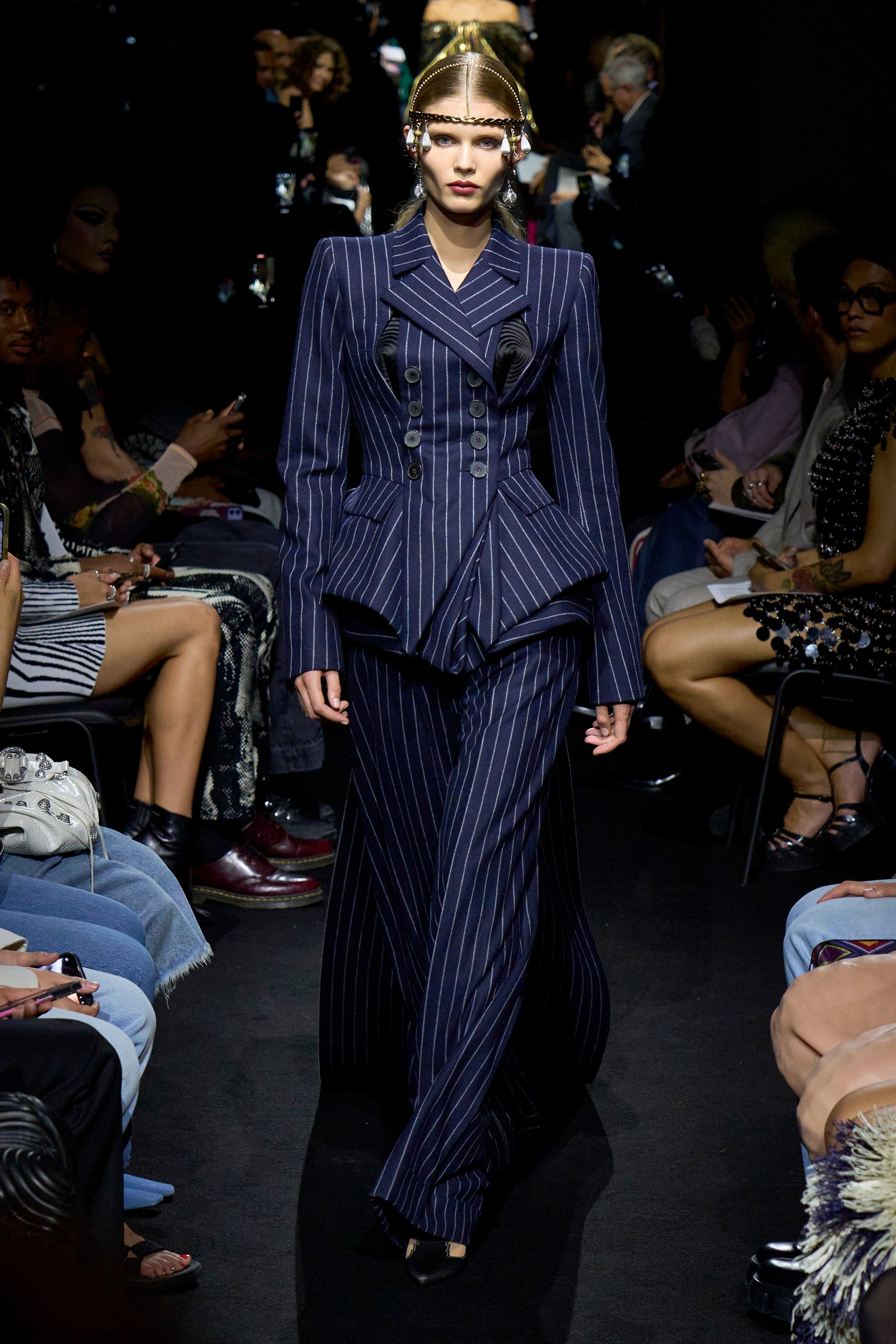
Jean Paul Gaultier Couture A/W´23
This couture season is the fifth time that a guest designer has been selected to interpret Jean Paul Gaultier’s work, the latest candidate being Julien Dossena, whose day job is creative director at Paco Rabanne. It marks Julien’s couture debut, given that he usually designs ready-to-wear and, really, that’s the wonderful thing about Gaultier’s current revolving-door format of visiting designers. Somewhere between Jean Paul and Paco – two fashion legends with their own distinct rebellious streaks – Julien dreamt up a love letter to Paris, with each look named after the city’s monuments, soundtracked to street noise and footsteps on the city’s cobblestones. In a dark space at Gaultier’s Rue Saint Martin HQ, with seats so tightly packed in that guests were almost knee-to-knee, there was a nocturnal mood in the air as Natalia Vodianova opened the show in a dramatically long black military tailcoat, embroidered with golden scissors, Eiffel towers and cannetilles — riffing on palace liveries and the pomp-and-splendour of official uniforms — with a braid of gold wrapped around her slicked-back hair like a Grecian goddess. Immediately, it was clear that this would be a roll call of some of Gaultier’s greatest hits, seen through the eyes of an adoring fan who has introduced his own hyper-modern take on boho femininity and space-age sequins during his time at Paco Rabanne.
Each look told a story of Julien’s lifelong respect for Jean Paul, who first blasted out from his television as a child growing up in Brittany. “Jean Paul was the first designer I ever saw on TV when I was very young,” Julien said in an interview. “Watching him, I understood for the first time: oh, fashion can be a job! What he did (became) infused into my cultural background in general.” So, bien sur, there were references to his favourite moments: Eve naked under a sheer slip dress with a merkin of black pearls from Gaultier’s “Adam and Eve” show and the giant trapper hats and floor-sweeping chapka black coats from the controversial “Rabbi Chic” collection. There was also the design signatures that have now become the canon of fashion folklore: marabou renditions of the Breton stripe, chainmail editions of punk tartan, underwear as outerwear, and the bustiers with cone breasts that immediately bring to mind Madonna circa Blonde Ambition (albeit entirely in silver chainmail as a double-salute to both Jean Paul and Paco). Half way through, there were audible gasps as Ashley Radjarame emerged in silver chainmail, with an anamorphic train connected to the suit of a man behind her, carrying the train. It was one of those oh-so-couture moments; not just a gimmick, but a reminder that sometimes clothes — often at Gaultier — can be spectacular entertainment at the hands of a great designer.
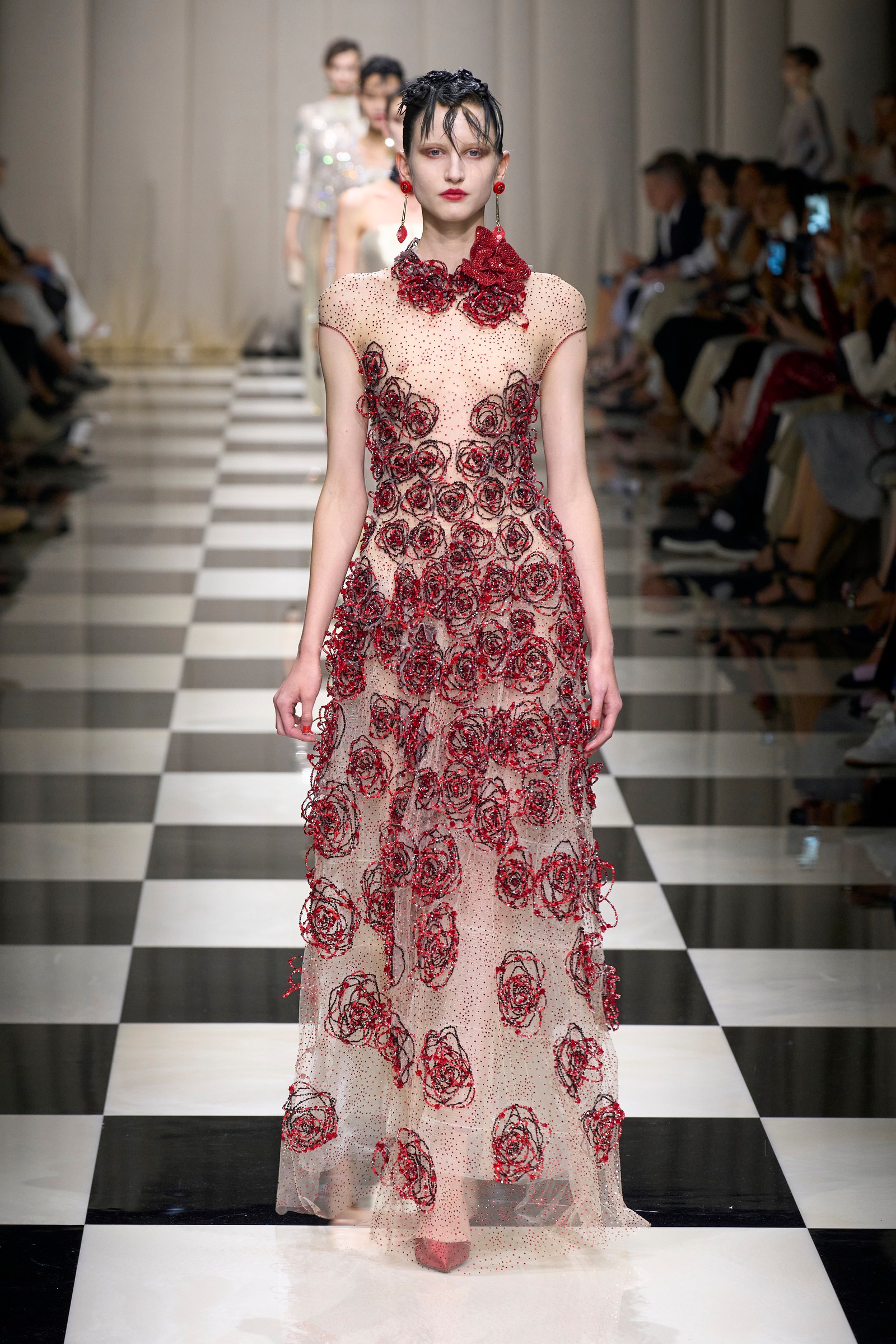
Armani Privé Couture A/W´23
As fashion’s most decorated eminence, Mr Armani knows what he is doing and, more importantly, who he is speaking to. He is one of the few designers on the couture calendar who is part of the world for which he designs — a billionaire in a tailor’s smock. His own yacht, the 65-metre black Codecasa superyacht Maìn can often be spotted docked on the shores of Pantelleria, where he has a sprawling estate, and then there are the multiple beige-suited Armani hotels, the jet, the other homes in Saint Tropez, Antigua, New York, Milan and St Moritz, to name a mere few. So he needn’t aimlessly wonder what the jet-set wants because he already knows. His couture serves the needs of the world’s elite shoppers.
Always one to pick a theme and stick to it – exploring a singular narrative in myriad ways – this season Mr Armani looked to the simple red rose, a universal symbol of love. Sequined roses, 3-D chiffon roses, conceptual roses, hair swirled into roses, roses on shoes, as buttons, as chiffon corsages, as bouquets of organza appliqués on capelets, as petal-light perfume sprayed throughout the venue. A rose by any other name! It all came in his signature long-stemmed silhouettes, often heightened by pagoda shoulders and streamlined trousers. Occasionally, there was an air of Chinoiserie through coromandel embellishments and lacquered red motifs. Brave, in these times, but also a reminder of couture’s global clientele. Next week, Mr Armani will be celebrating his 89th birthday. It’s safe to say he knows what he’s doing.
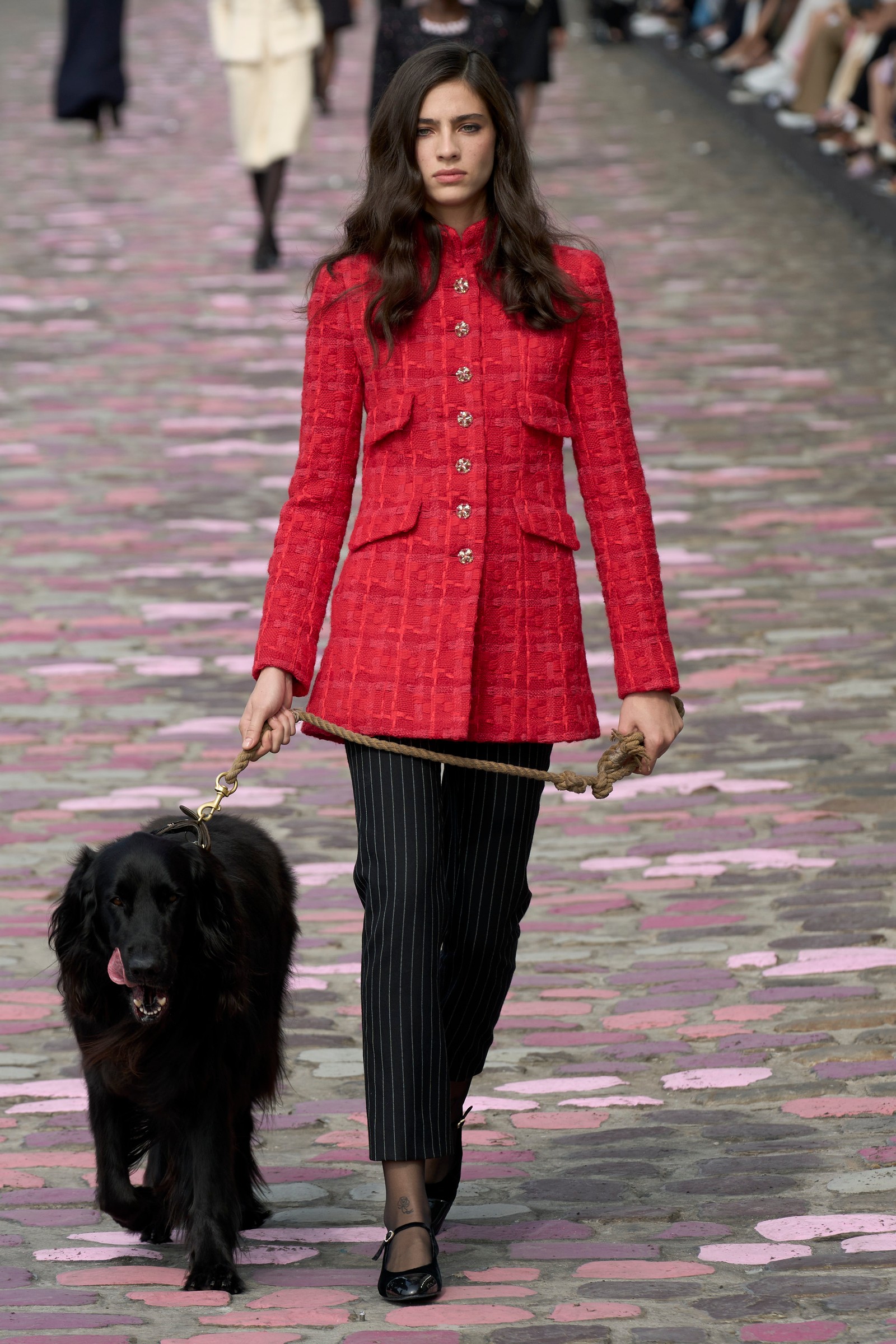
Chanel Couture A/W´23
What does a perfect day in Paris look like? Probably a walk along the Seine with a croissant and a black labrador, a perusal of a quayside bouquiniste for some vintage prints and art books, a trip to 31 Rue Cambon for a couture fitting, a cinq-a-sept romp, followed by dinner at a brasserie and a night out at Maxim’s. Who wouldn’t want that? Chanel’s creative director Virginie Viard knows what the world wants from Paris: the classics. Her latest plein air couture show was held on the cobblestones along the river, opened by long-time Chanel ambassador Caroline de Maigret, who literally wrote a book titled How to be Parisian Wherever You Are. Virginie knows that women the world over are obsessed with the idea of La Parisienne and her secrets to insouciance. It’s why there are so many beauty tutorials, style guides and diet books devoted to demystifying the way that French women — Parisian women, really — manage to look so good. It’s what Lily Collins’s character in Netflix’s Emily in Paris has been trying to figure out since the pilot episode. “What the Parisienne wears, what she reads and thinks, her very attitude to life, is closely inspected and studied,” read the collection’s accompanying text. “All over the world, by opposition or imitation, she sets an example that nourishes others.”
This was a collection that riffed on the great hits of Parisian style, all the way from Modish bouclé skirt suits of Nouvelle Vague cinema to the wicker baskets and peasant blouses of the Left Bank in the 70s, to the polished primness of the 80s (the decade Virginie began working at the house). Sartorially speaking, the collection took shape with long, masculine tweed coats thrown over embroidered skirts and tapered trousers, and a handful of dresses and blouses artfully embellished with delicate sequined flowers and wild fruit, so real they could have been picture-perfect. Straw boaters and two-tone Mary-Janes completed the look (bien sur) while the occasional silk blouse, flower-strewn basket and ruffle of ombré organza brought a playful sense of lightness that can often go amiss in Elysian fields of haute couture. “Sophistication and simplicity, permanence and beauty,” is how Virginie put it. As her collections continue to prove, it’s an age-old local recipe for success.
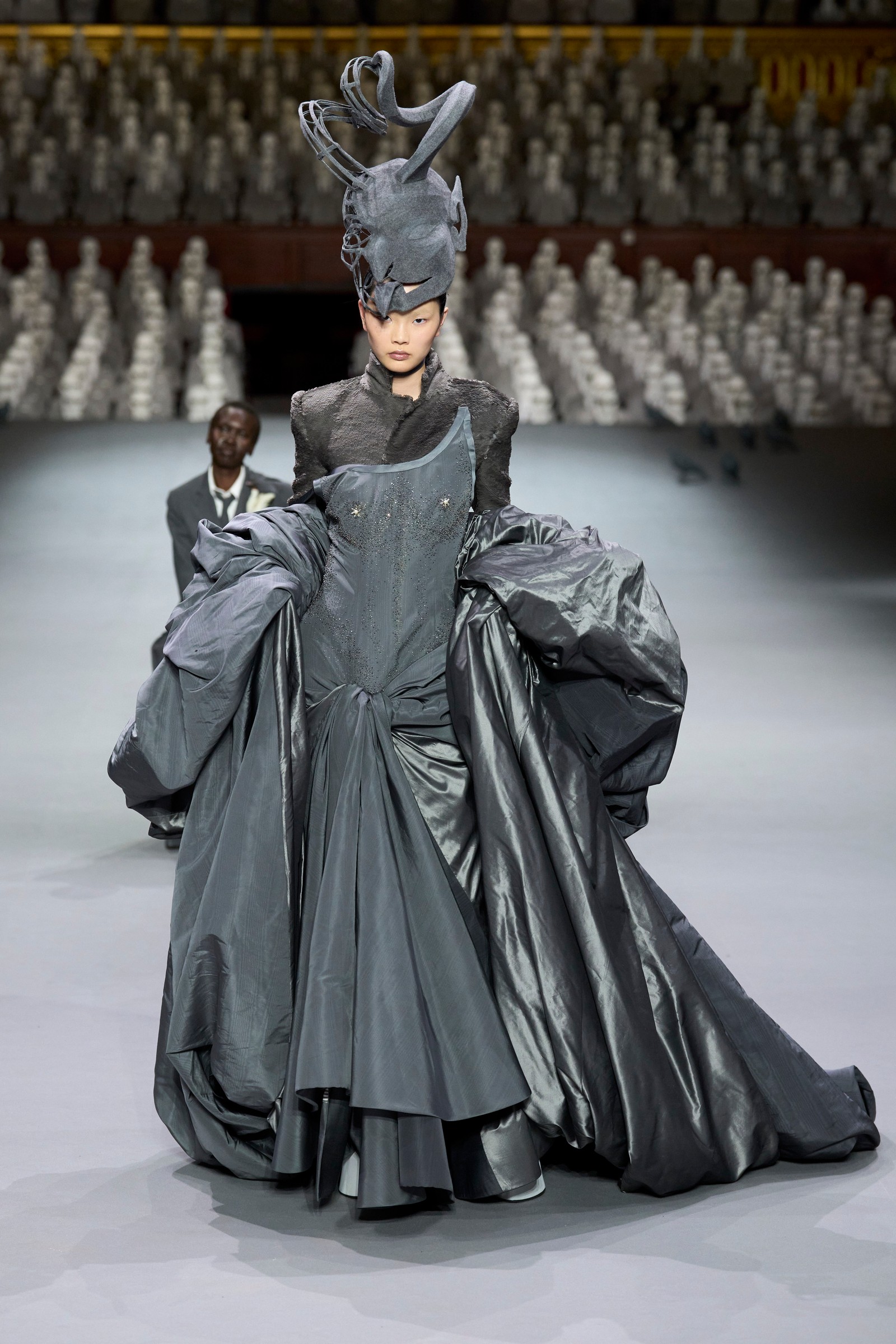
Thom Browne Couture A/W´23
Officially venturing into couture for the first time wasn't too much of a leap for Thom Browne, who for all intents and purposes already does couture. There were no doubts he'd be able to hold his own. Still, the designer made the most of his first slot on the Paris haute couture calendar with a collection that elevates the signatures of his 20-year-old brand — especially that unmistakable grey suit. Per the show notes, "elements of classic american sportswear filtered through the lens of couture. for one night only." (The brand's marketing materials are famously always devoid of uppercase letters.) The show took place Monday on stage at the Palais Garnier, with 2,000 grey-suit-clad cardboard cutouts filling the audience. (Human guests sat on either side of the stage itself.) Thom Browne shows always tell a story; this one took place at a train station, as evidenced by train sounds, a large striped bell hanging overhead, prop pigeons and a passenger: the grey-suited Alek Wek, who began the show by sitting in the middle of the stage atop a pile of chic matching luggage. The rest of the models walked slowly around her as the show went on and the "bell" "chimed," signaling the passage of time.
Pigeons (known to inhabit train stations) also feature prominently in the collection itself — sometimes more literally, via bird-shaped headpieces, and otherwise more broadly, via gradient grey-and-white looks that recall most pigeons' natural coloring and footwear that vaguely recalls their feet. A bell motif is also seen throughout, in eye-blocking cloche hats and gilded adornments on the backs of some of those very precarious platform shoes. The show included plenty of other show-stopping headwear as well, including a mohawk-like, train-shaped hat and an enormously tall, partially deconstructed train conductor cap. The off-kilter grey wigs several models wore also feel like they fall into this category. Speaking of accessories, bags — from suitcases to purses (not all of them dog-shaped) — were also a focal point of the show; it's a more commercial styling decision than is often seen in couture.
Pigeons (known to inhabit train stations) also feature prominently in the collection itself — sometimes more literally, via bird-shaped headpieces, and otherwise more broadly, via gradient grey-and-white looks that recall most pigeons' natural coloring and footwear that vaguely recalls their feet. A bell motif is also seen throughout, in eye-blocking cloche hats and gilded adornments on the backs of some of those very precarious platform shoes. The show included plenty of other show-stopping headwear as well, including a mohawk-like, train-shaped hat and an enormously tall, partially deconstructed train conductor cap. The off-kilter grey wigs several models wore also feel like they fall into this category. Speaking of accessories, bags — from suitcases to purses (not all of them dog-shaped) — were also a focal point of the show; it's a more commercial styling decision than is often seen in couture.
Of course, couture-level artistry is still everywhere in the collection, even on the more simple tailoring pieces, via trompe l'oeil techniques, whimsical intarsias, intricately woven knits and rich embroideries. Much of the latter depicts beautiful aquatic imagery — marine life, lighthouses, rope. (Perhaps our passenger is headed somewhere less grey and more tropical?) For formalwear, there are a smattering of extravagant-yet-covered-up gowns designed to look like a dress, coat and cape all layered together. To close out the show, the couture bride (Grace Elizabeth) came out in a white, gauze-y, glittering, leg-baring suit dress with a very long train (get it?). It's what Wek had been waiting for: With two porters carrying her luggage, she waved goodbye and set off on her journey.
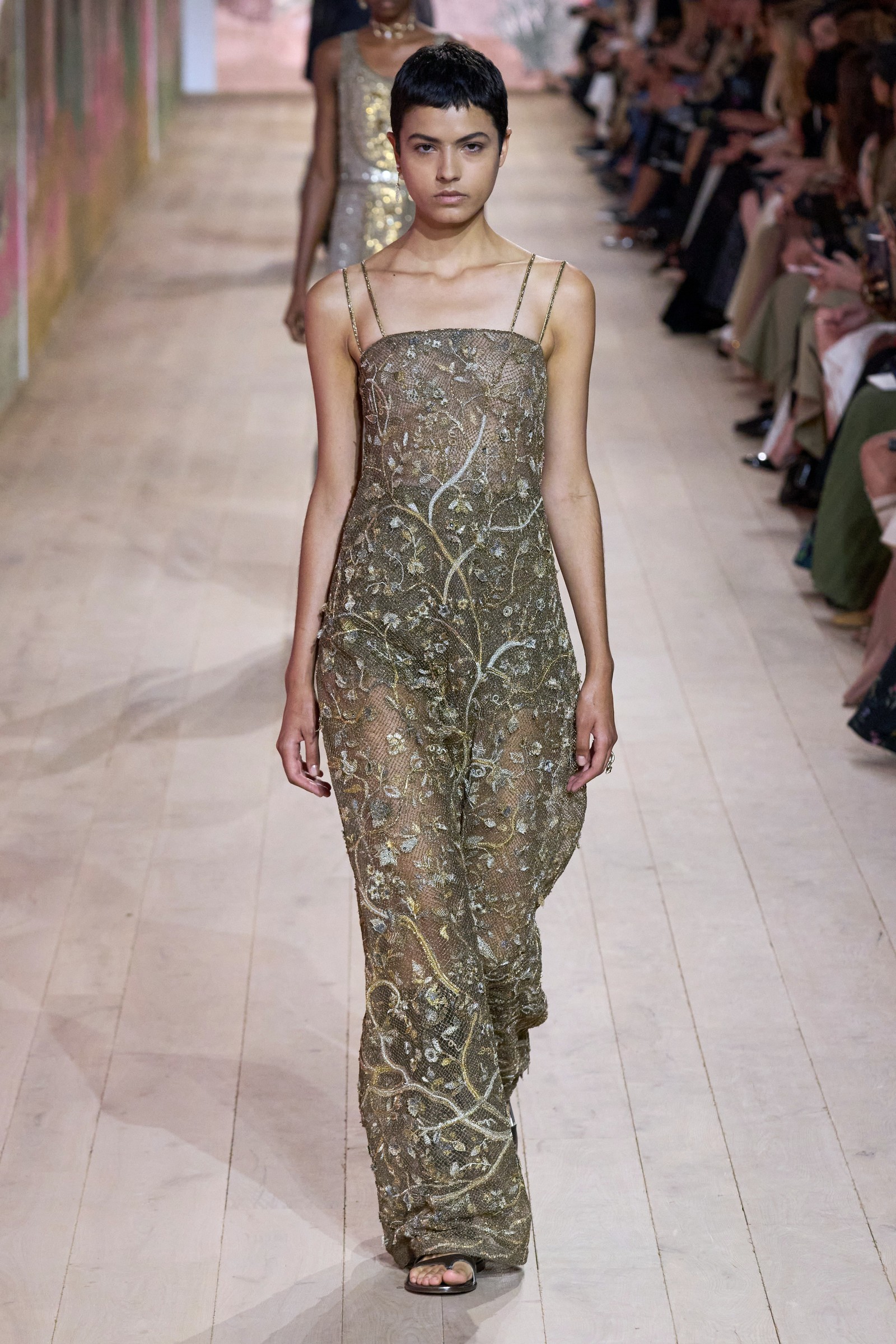
Christian Dior Couture A/W´23
Quiet luxury has been percolating for a while on the ready-to-wear wagon, with designers offering up subtle (but no less extravagant) wardrobe propositions for those wealthy enough to not need to obviously display their wealth in recent seasons. Surely in the realm of haute couture, however, clients want the exact opposite: Blinding embellishment! Out-there silhouettes! Fantastical gowns for a real-life fairy-tale! Dior’s Maria Grazia Chiuri begs to differ. In fact, as she pointed out during a preview of her latest couture collection, some Dior clients want one-of-a-kind clothes for every day, even for the office. “Some of these women don't use couture only for special moments but also for more professional moments — and they want an entire couture wardrobe,” she revealed. You can understand why, then, her latest collection was pared-back to the classicism more commonly found in Greco-Roman antiquity with a procession of clean-lined, unfussy floor-length looks that hinted at the drapery of classical statues and the quietness of minimalism. Pinned to her mood board backstage was a quote from Monsieur Dior himself: “My dresses are connected to the idea of the clothes of antiquity. I keep an apparent simplicity.” It resonated with Maria Grazia’s broader mission to opt for construction over embellishment, loosening waists where Dior cinched them in.
But not everything at Dior is as simple as it looks: grey Bar jackets came with artfully pleated caped sleeves, long summery white dresses with hand-stitched ‘sfilato’ openwork, floor-sweeping capes in ivory double-faced cashmere as light as a feather, diaphanous goddess gowns with intricate embellishments. Most of the looks came in ankle-skimming proportions with the roominess of Roman togas, and though they might seem simple, the couture wow factor could be found in the all-over pearl embroideries, beaded lace capes and burnished-gold embellishments applied to otherwise pared-back silhouettes; ecclesiastical splendour meets monastic simplicity. Even the set required closer inspection — as usual, Dior took over the Musée Rodin in Paris, building a pop-up art-gallery-meets-catwalk in the garden with walls lined by artworks by Italian artist Marta Roberti, which took more than 480,000 hours of embroidery by the Chanakya workshop in Mumbai to complete. Up close, it’s incredible to see how much work goes into every stitch, which serves as a reminder that couture must be seen in real life to be truly appreciated — which seems like an antidote to the bells-and-whistles spectacles elsewhere. “Couture worn by celebrities has become a kind of personal performance,” Maria Grazia noted, “but it can also be simple silhouettes, very comfortable clothes, flat shoes.” This is haute couture that prioritises women who will ultimately buy it and wear it, whether it’s for a wedding or just another day in the office.
Alaïa Couture A/W´23
OK, I know what you’re thinking. Alaïa may not be a couture house per se — at least not technically since it shows the day before Couture Week officially kicks off — but it is home to some of the finest dressmaking in Paris under the creative directorship of Pieter Mulier. On a breezy Sunday evening, Pieter invited guests to bring their own chairs (an Alaïa-leather camping stool which acted as the invite for the show) to the Solferino footbridge covered in lovers’ padlocks at the bottom of the Musee d’Orsay. Again, I know what you’re thinking: another fashion show on a bridge? Minutes before the show, Pieter personally WhatsApped every single guest with a heartfelt poem: “To meet on a bridge / Just before sundown / When beauty spreads / In the city / And colours expand / Infinitely”. That’s the thing about Alaïa: although it may not be the biggest fashion house, it is one of the most intimate, and every one of Pieter’s shows has felt like a personal invitation into his world — last season, quite literally, when he invited guests to his home in Antwerp. As for the clothes, they were labours of love, riffing on the idea of time. “Giving time, taking time, less time, timeless,” read the show notes. “The elastic notion of time has always had a special meaning at the house of Alaïa - eschewing its conventions and restrictions, embracing its possibilities — Pieter Mulier explores time not as an abstract concept but a material notion, its signs and signifiers, its reflections through fashion.”
A lot of noise is made by fashion houses about the notion of time, and how many hours have gone into the making of a garment, but none can light a match to the incendiary ferocity of Alaïa. Beyond craftsmanship, it’s brilliantly sexy — and this time the models emerged with long ponytails swaying like whips, leotards rising up to whittled waists, pencil skirts and skin-tight dresses with inbuilt padding and corsetry that gave each girl a sartorial BBL. Pieter used buttons as a symbol of time, dotting them across tailoring with as many as 35 on one coat — “the ritual of dress, of fastening oneself into a garment, a time of change and reinvention, a promise of future revelation at their unfastening,” he explained. There were examinations of the extensive archive that Azzedine Alaïa left behind – symbols of time past and then renewed for today – like the thonged bodysuits, sculptural leathers and balloon-sleeved knits. But perhaps the timeliest idea was the push-and-pull tensions of ostensibly opposing ideas, echoing the notion that women contain multitudes: covered-up modesty versus knicker-flashing sexuality; the buttoned-up primness of tailoring and pillbox hats versus symbolically kinky latex pencil skirts; the ease of a tank top juxtaposed with inbuilt corsetry. Make no mistake: this was a wardrobe for a woman in complete control of her own body, unafraid to embrace sexuality in the most brazen way. And yet, it’s as chic as any cliché about La Parisienne — which is why passing bauteaux mouches of tourists looked up in wonder as they witnessed the parade of women crossing a bridge in stilettos and pill-box hats. That sense of duality is what feels timely in 2023.
Schiaparelli Couture A/W´23
“After last season, which was about reducing each look to something concise and even sometimes arresting, my instinct here was to build the collection in a different way, for a collection that adventures, explores and dares,” Daniel Roseberry explained of his show for Schiaparelli. There was notably less gold than Daniel’s previous explorations of kitschy baroque surrealism, and instead, he opted for brushstrokes of his favourite artists as sartorial status signifiers. Jack Whitten’s mirrored mosaics became broken-mirror stitch cardigans and skirts, a playful take on the grande dame twinset and apt; leather cigarette boxes trimming a ballgown were a homage to Sarah Lucas’ sculptures; pebble-like beads and vivid cobalt blue nodded to Yves Klein; brooches took their shape from the sculptures of Claude Lalanne; Matisse’s palm fronds at the Hotel Regina were interpreted as a dramatic faux monkey-hair coat quivering around the body. Daniel and his team even hand-painted a woman’s body with brushwork inspired by Lucien Freud, and then transferred that image to a stretch silk body stocking, where each brushstroke was rendered in shimmering paillettes clinging to skin.
“After last season, which was about reducing each look to something concise and even sometimes arresting, my instinct here was to build the collection in a different way, for a collection that adventures, explores and dares,” Daniel Roseberry explained of his show for Schiaparelli. There was notably less gold than Daniel’s previous explorations of kitschy baroque surrealism, and instead, he opted for brushstrokes of his favourite artists as sartorial status signifiers. Jack Whitten’s mirrored mosaics became broken-mirror stitch cardigans and skirts, a playful take on the grande dame twinset and apt; leather cigarette boxes trimming a ballgown were a homage to Sarah Lucas’ sculptures; pebble-like beads and vivid cobalt blue nodded to Yves Klein; brooches took their shape from the sculptures of Claude Lalanne; Matisse’s palm fronds at the Hotel Regina were interpreted as a dramatic faux monkey-hair coat quivering around the body. Daniel and his team even hand-painted a woman’s body with brushwork inspired by Lucien Freud, and then transferred that image to a stretch silk body stocking, where each brushstroke was rendered in shimmering paillettes clinging to skin.
“A Surrealist’s interpretation of a woman’s essential closet,” is how Daniel described his takes on wardrobe classics, albeit with a collection in which every look counted towards the extreme vision of clothes as wearable art: sculptural, Brobdingnagian proportions jutting away from the body; giant wooden necklaces, exposed corsetry, painted bodies, duvet-like padding; an insane amount of colour and embellishment. You don’t need to look to closely to get the full effect. In fact, you could argue that this kind of couture resonates on a much broader scale, instantly understandable (if not entirely wearable) in images and videos that quickly go viral. Schiaparelli, a house that has roots in the crossover between fashion and art, always puts on a show that feels like a surreal performance piece. This is fashion for the sake of folly, an opportunity to turn the biggest ideas into the biggest clothes and make use of couture ateliers as a site for experimentation. Daniel is a designer who believes in fashion’s power to provoke genuine emotion, not just for those wearing it but for those simply viewing it online — clothes that shout from the grey-slate rooftops of Paris. Quiet Luxury, be damned!



No comments:
Post a Comment